Beer is the oldest alcoholic beverage, the popularity of which is growing every century. Currently, about a thousand of its varieties are known, differing in taste, color, strength and manufacturing technology. A narrow circle of specialists was engaged in the manufacture of the drink, each of whom created his own product using ancient family recipes. Today this process is available to everyone. It is enough to purchase inexpensive equipment, ingredients, read the instructions and start creating your masterpiece. The editorial staff of the site "bestx.htgetrid.com/en/" offers you an overview of the best home brewery models for 2020, based on customer reviews and expert recommendations.
Content
A bit of history
Sitting on a hot day on the outdoor terrace and enjoying a cool frothy drink in a misted glass glass, we touch the history of the ancient world.
Interesting! The taste of the foamy drink to a large extent depends on what kind of dish you drink it from! The ceramic mug is the same age as the drink itself. Now preference is given to glassware because you can enjoy both the taste and color of the drink.
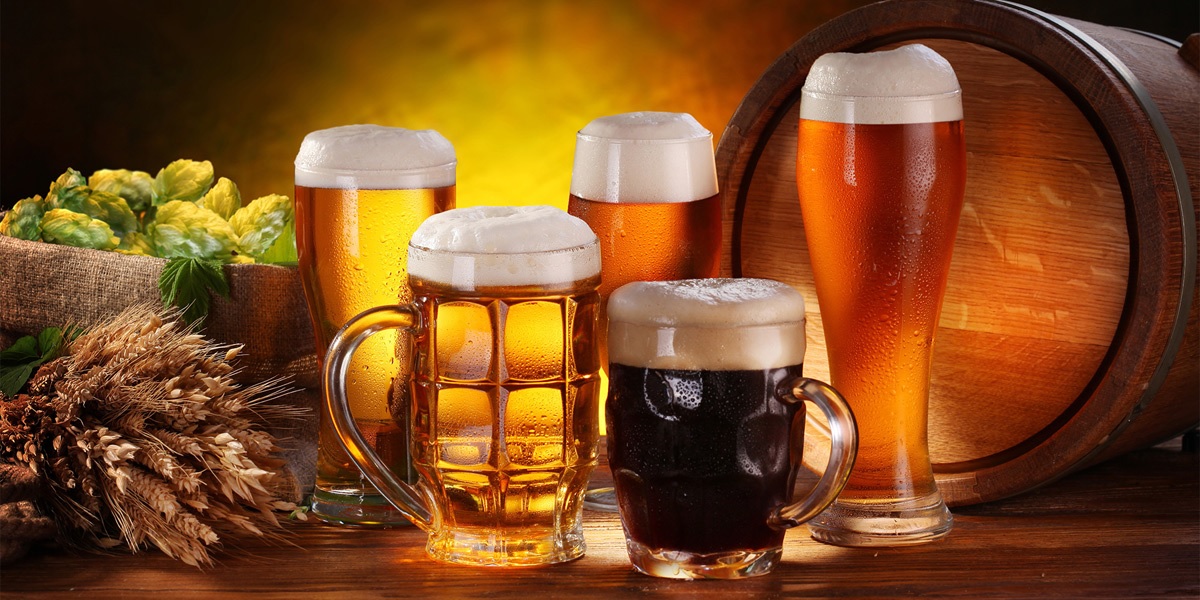
The first recipes for the drink, recorded in Sumerian cuneiform, tell that at that time the main ingredient was an ancient wheat variety - spelled... After grinding, barley, aromatic herbs, water were added to it and fermentation began. The resulting product (wort) serves as the basis for making beer.
The inhabitants of ancient Babylon made their contribution to improving the taste of the drink. It was they who began to germinate and then dry the grains, obtaining malt. Additives of honey, oak bark and tree leaves have been widely used to add flavor to the composition. The taste was excellent, but the malt and grain drinks were not stored for more than one day. From Babylon, the product gradually reached Egypt, conquered Persia, India and the Caucasus. It was not possible to conquer Greece. Wine was preferred there.
From Babylon, the product gradually reached Egypt, conquered Persia, India and the Caucasus. It was not possible to conquer Greece. Wine was preferred there.

In the Middle Ages, beer experienced a rebirth thanks to German brewers. It was they who began to add hops to their product, which improved its taste and greatly increased its shelf life. The superiority of the Germans in this matter is disputed by the Slavs, who prepared a drink with hops in the 11th century.
The superiority of the Germans in this matter is disputed by the Slavs, who prepared a drink with hops in the 11th century.
The next stage in the development of this industry falls on the 19th century. Thanks to the discoveries of Louis Pasteur and Emile Christian Hansen, an employee of the oldest Danish company Carlsberg, who received brewer's yeast in 1881. From this point on, artisanal brewing gradually became industrial.
Technology
Before you know what home breweries are, you should familiarize yourself with the process technology. Let's start with raw materials:
- Malt. Germinated and dried grains of cereals. Used for making wort.
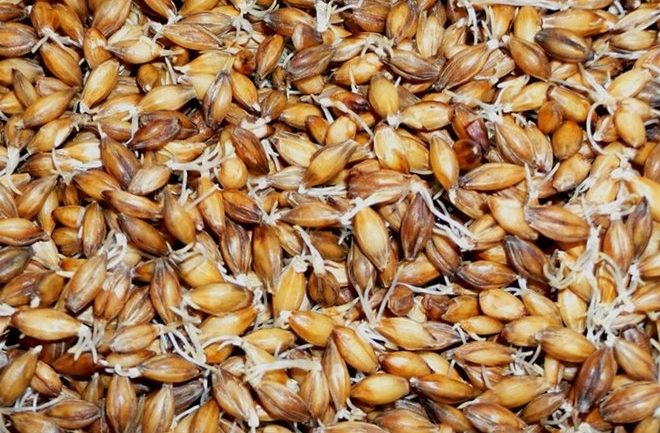
- Hop.Plant of the same genus. The tannins contained in it help to regulate fermentation and prevent the composition from souring.
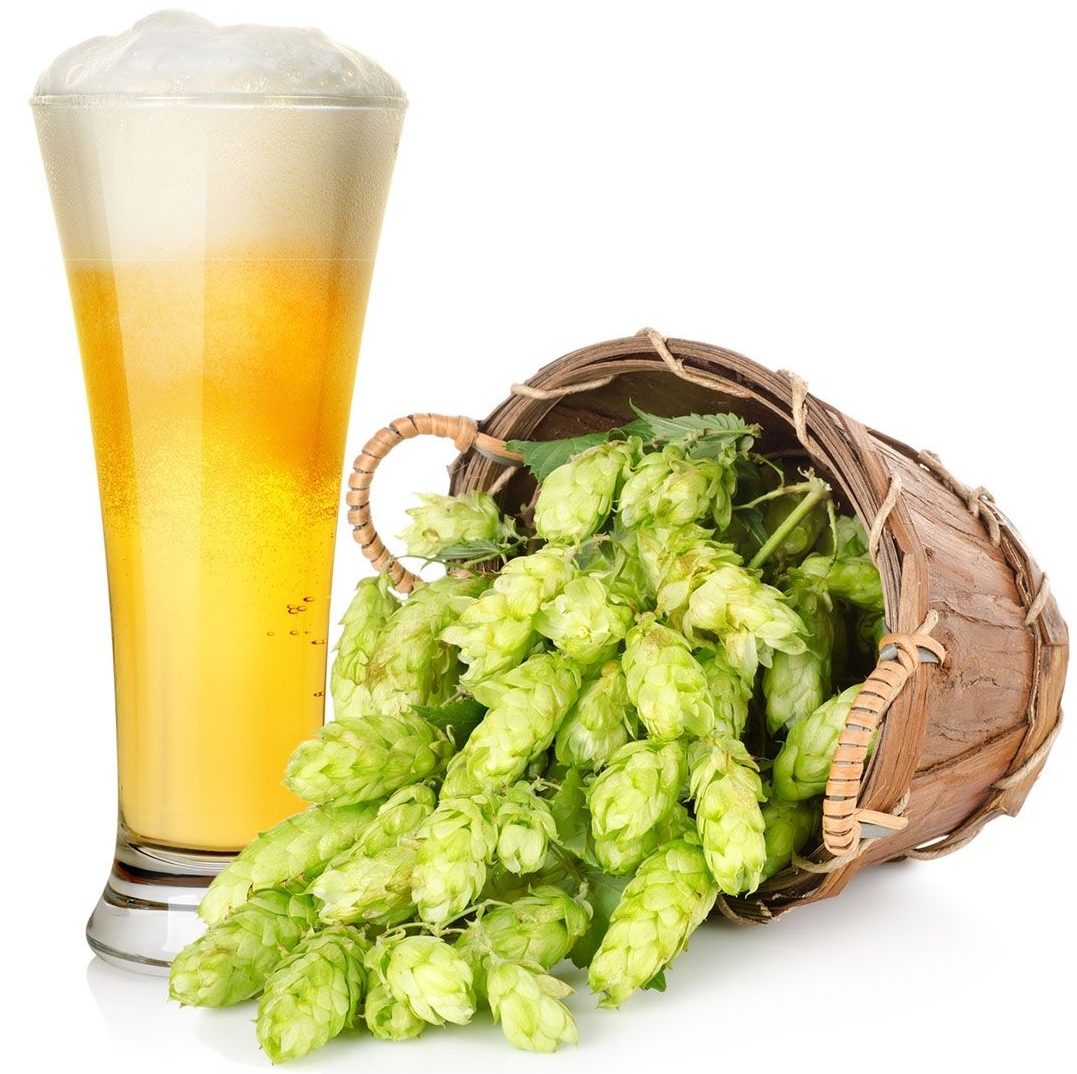
- Brewer's yeast.
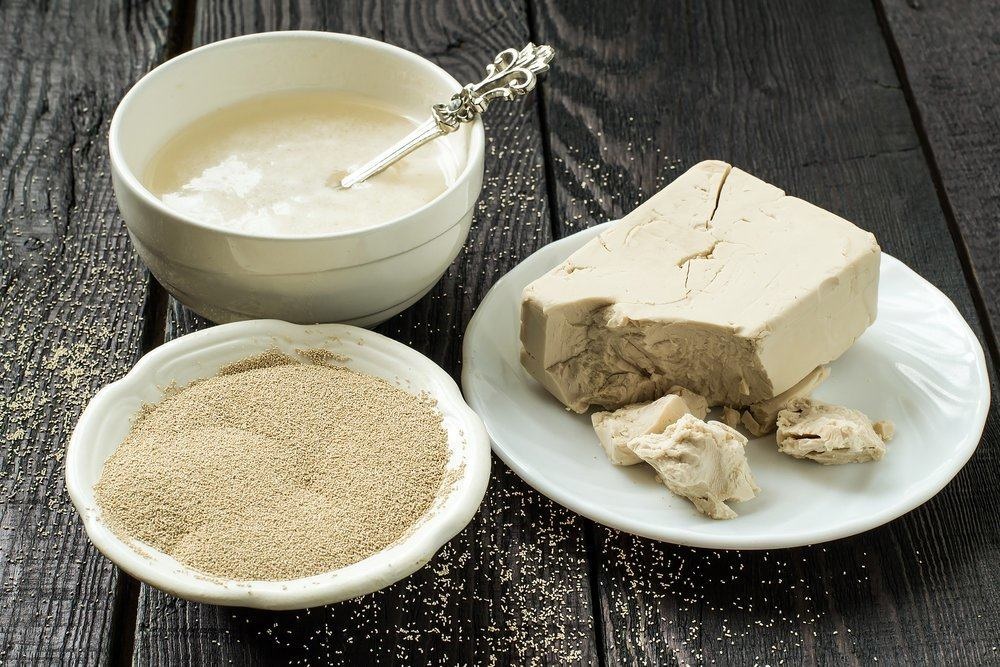 A group formed by unicellular fungi that live in a liquid and semi-liquid state. Distinguish between the wild and cultivated form of brewer's yeast, bred by E.K. Hansen, who first used them for brewing. Before him, leaven was used in the manufacture of a foamy drink.
A group formed by unicellular fungi that live in a liquid and semi-liquid state. Distinguish between the wild and cultivated form of brewer's yeast, bred by E.K. Hansen, who first used them for brewing. Before him, leaven was used in the manufacture of a foamy drink.
Stages of preparing a drink
Preparatory stage
The presence and required quantity of all ingredients, the readiness of the equipment and the availability of empty containers for finished products are checked. At this stage, all equipment is sterilized. This can be done by thoroughly rinsing the dishes with hot water and hands with soap. It is easier and safer to use commercially available special tablets containing bleach. Disinfection of dishes and equipment is a very important process. It depends on its exact implementation whether you will get the desired foamy drink or mash at the exit, from which nothing good will come of, except for moonshine. And this will surely happen when wild yeast and pathogenic organisms get into the wort.
To get a quality drink, it is better to use bottled water. If this is not possible, ordinary tap water can be dispensed with, after it has settled for 24 hours. This time is enough for the complete weathering of chlorine and the precipitation of other harmful impurities.  The settled water is poured into a clean dish with a thin tube, without disturbing the sediment.
The settled water is poured into a clean dish with a thin tube, without disturbing the sediment.
Half an hour before adding brewer's yeast, they must be diluted with warm water, but not warmer than 28 ° C, following the recommendations on the package.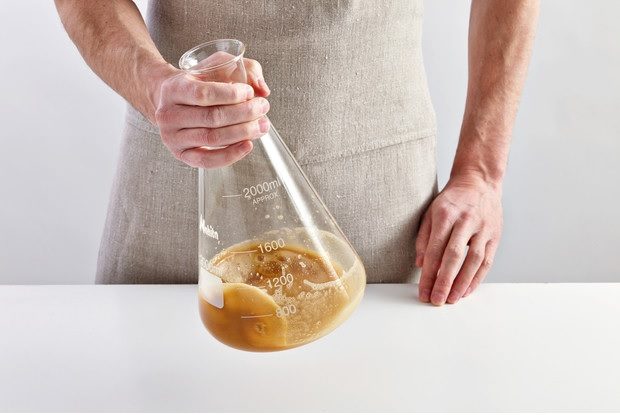
Cooking the wort
This is the name of the stage during which the crushed malt is mixed with hot water, as a result of which the starch contained in the grains is broken down into maltose (malt sugar) and dextrose (D - glucose). To make life easier for beginners, you can purchase malt in finished (crushed) form. If there is no such product nearby, you will have to crush the sprouted grain yourself.
Important! The malt should really be crushed, not ground into flour. Ready-to-mash malt consists of pieces of grain, always with a peel, the presence of which makes it easier to filter the composition
Water in the amount of 25 liters is placed on the stove in an enamel or stainless container and heated to 80 ° C. After grinding, the malt is poured into a cloth or gauze (of four layers) bag, its heated water is lowered and boiled for an hour and a half at a temperature of 61 - 72 ° C. At this temperature, the breakdown of malt into sugars is more intense (the yield of sugars is more complete), increasing the "degree" of the home product. By raising the temperature to 68 - 72 ° C, the master achieves an increase in the density of the wort. The strength of the beer decreases, but the taste becomes more intense.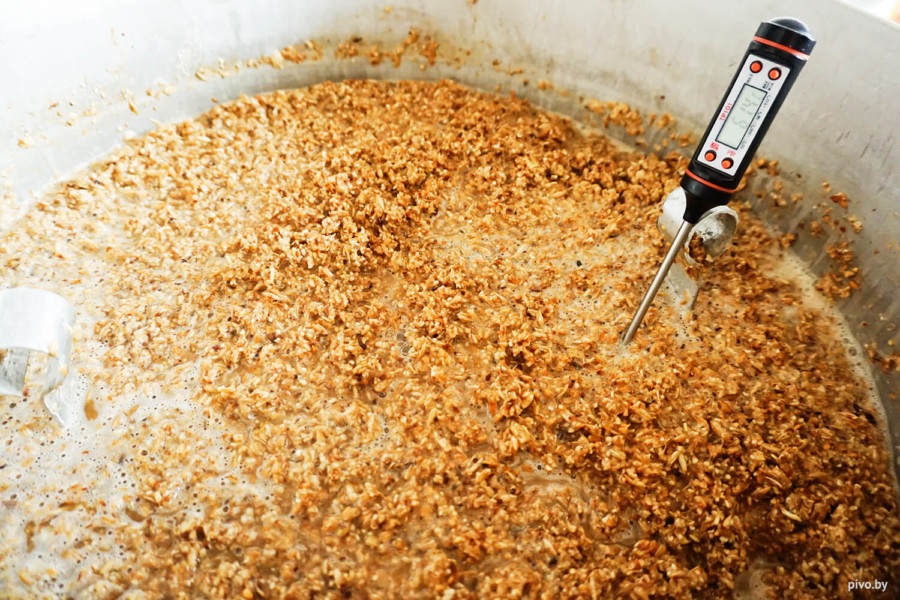
Heating the mixture for 90 minutes should result in complete decomposition of the starch. To verify this, an iodine test is done. A small amount of wort is mixed on a white plate with a few drops of iodine. If the solution turns blue, cooking continues for another 15 minutes. Then the temperature is sharply raised to 80 ° C and the composition is boiled for another 5 minutes, until the enzymes work completely.
The bag with the remaining contents is removed from the cooking vessel and washed with boiled hot (78 ° C) water in the amount of two liters, washing out the rest of the extract. Water from washing is added to the wort. This method of mashing malt eliminates the need for filtering and significantly saves the master's time.
Boil the wort
The resulting composition is brought to a boil and 15 grams of hops are added. After another half hour of boiling, a second dose of hops is added in the same amount. Another 40 minutes will pass and the last addition of hops (the same 15 grams) will be used, after which the boiling continues for another 20 minutes. The entire stage continues for 90 minutes, during which the product must constantly boil.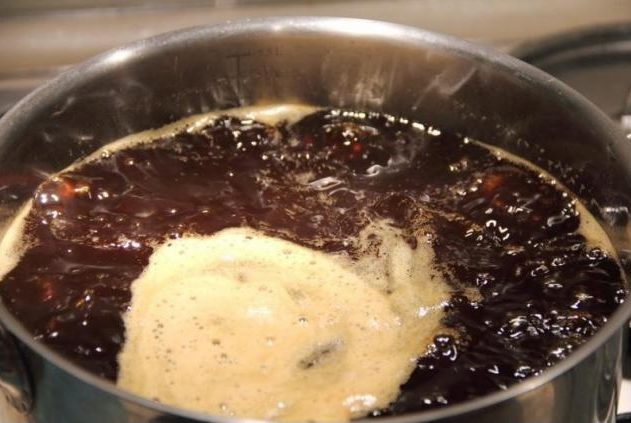
Cooling the wort
Now the resulting semi-finished product needs to be cooled very quickly to 25 ° C.The less time is spent on cooling, the less opportunities the product has to “pick up” bacteria harmful for fermentation or wild yeast. For cooling, you can use a homemade coil with running water by placing it in a bowl of wort. Or quickly immerse this vessel in an ice bath, trying not to overturn the container on your way along the way. The cooled semi-finished product must be carefully (through cheesecloth) poured into a fermentation vessel.
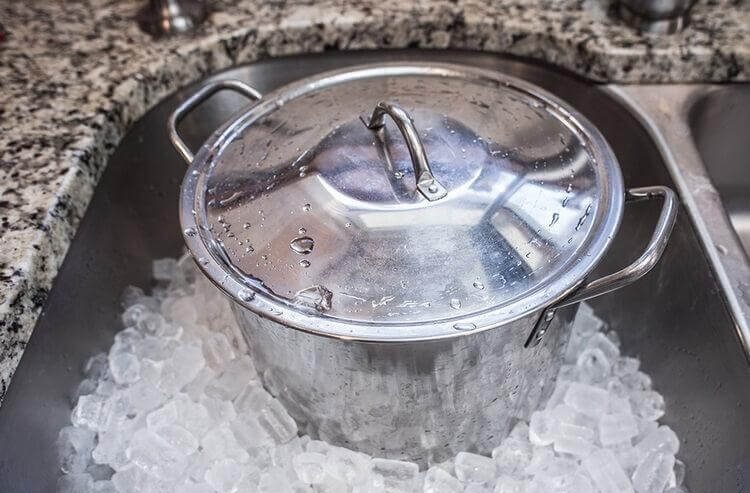
We start the fermentation process
Brewer's yeast is bred strictly following the instructions for temperature and proportions prescribed on the package.
On a note! Yeasts are top-fermented and bottom-fermented. The former operate at a wort temperature of 18 - 22 ° C, the latter - in the range from 5 to 16 ° C. Beer is different in both cases.
The horse method is more ancient. It was used before the invention of refrigeration machines. Today top fermentation produces English ale, Belgian lambic, German altbier, etc.
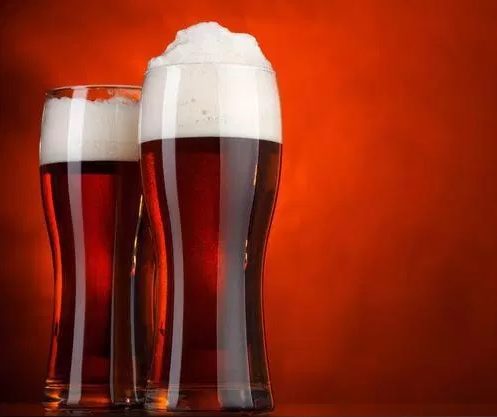 The product obtained on the basis of bottom fermentation yeast can be stored without pasteurization for 2 years, top fermentation - no more than six months.
The product obtained on the basis of bottom fermentation yeast can be stored without pasteurization for 2 years, top fermentation - no more than six months.
Bottom-fermented beer is called lager. The most famous varieties of lager beer:
- light American lager;
- Munich light;
- German, Bohemian and Classical American Pilsners;
- Viennese lager;
- Munich dark lager;
- Schwarzbier (black lager).
Fermentation of beer
The fermentation tank is transferred to a dark place with a temperature of about 25 ° C, equipped with a water seal and remains in this position for 7-10 days. After about 6-10 hours, the fermentation process begins, which will actively proceed for the next two to three days. This action can be observed by the presence of carbon dioxide bubbles in the water seal.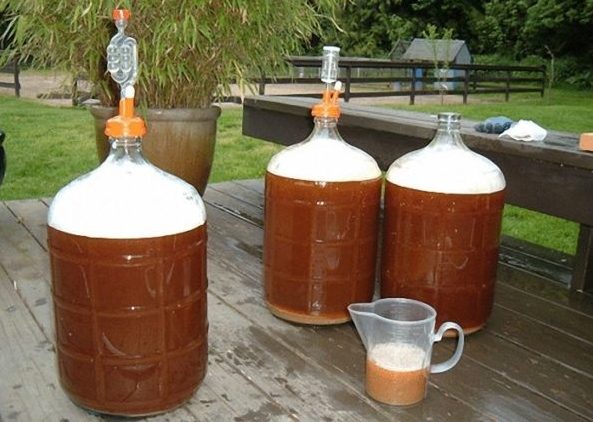 By the end of the ten-day period, the release of gas bubbles in the water seal gradually fades away. Fermentation is complete.
By the end of the ten-day period, the release of gas bubbles in the water seal gradually fades away. Fermentation is complete.
Natural carbonation
Sugar (8 grams per liter of beer) is added to the dishes prepared for bottling the products to initiate secondary fermentation, which will fill the drink with carbon dioxide, improving the taste and forming foam. This stage is called natural carbonation. The product is carefully poured into bottles with sugar through a tube, leaving the sediment intact at the bottom of the container. The tube should be in the middle of the fermentation vessel, and it is advisable to lower its other end as close to the bottom of the bottle as possible, reducing the contact of the potion with air.
This stage is called natural carbonation. The product is carefully poured into bottles with sugar through a tube, leaving the sediment intact at the bottom of the container. The tube should be in the middle of the fermentation vessel, and it is advisable to lower its other end as close to the bottom of the bottle as possible, reducing the contact of the potion with air.
Important! Yeast can accumulate on the surface or settle to the bottom of the container. If they get into the bottles, the product will be cloudy.
The dishes remain empty 2 cm from the edge of the neck and are clogged.
Full bottles are placed in a dark room with a temperature of about 20 ° C for another 20 days. Periodically, once a week, the contents are shaken. At the end of the exposure, the bottles are placed in a refrigerator. You can take a sample. But if you let the drink ripen for another month, it will become much tastier.
Forced carbonation
Artificial or forced carbonization of beer in kegs, special vessels for storing and transporting carbonated drinks is used. 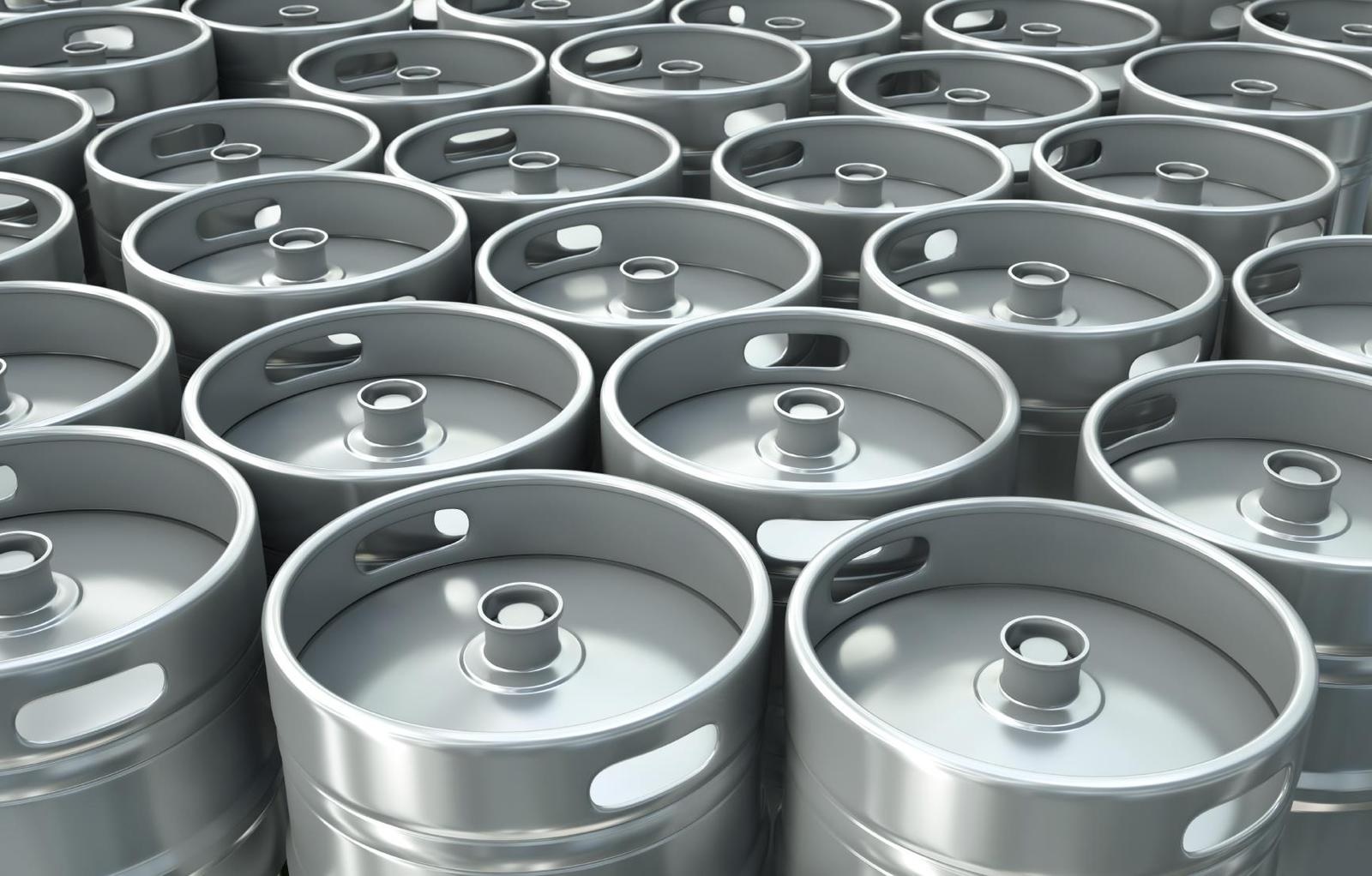 The keg neck is equipped with a special valve. The dispenser, connected by a hose to the carbon dioxide can, is put on the valve of the container, snaps into place and by turning the lever on the dispenser, the inlet valve opens. Carbon dioxide enters the vessel under pressure, saturating your favorite drink with bubbles.
The keg neck is equipped with a special valve. The dispenser, connected by a hose to the carbon dioxide can, is put on the valve of the container, snaps into place and by turning the lever on the dispenser, the inlet valve opens. Carbon dioxide enters the vessel under pressure, saturating your favorite drink with bubbles.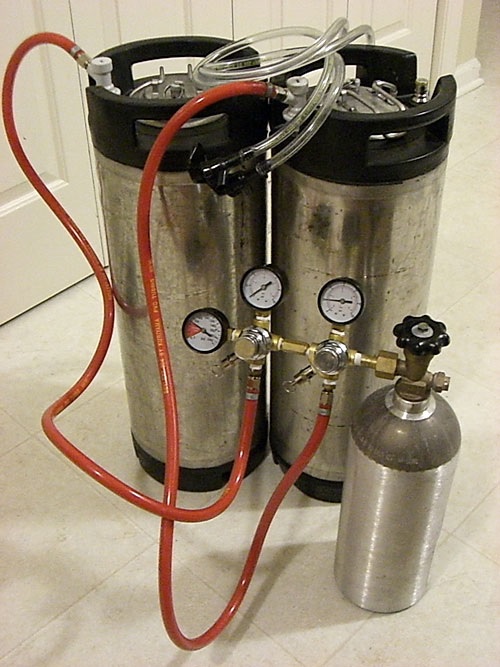
DIY brewery
If the desire to brew beer has become irresistible, you need to acquire the necessary equipment. The most affordable and budgetary option in this case would be to make the device with your own hands. This requires a stainless steel pot or tank with a lid.
- Having stepped back 50 mm from the bottom of the tank, a hole is drilled in the tank wall for the installation of the drain valve. Its diameter should be such that it can be threaded half an inch into the wall. An adapter DN 15 * 15 mm is screwed into the resulting hole. From the inside of the pan, it is fixed with a nut, from the outside we screw a tap with a sealing silicone gasket onto the adapter.Above the tap, (it is possible in the center of the tank), a thermometer is mounted in the same way.
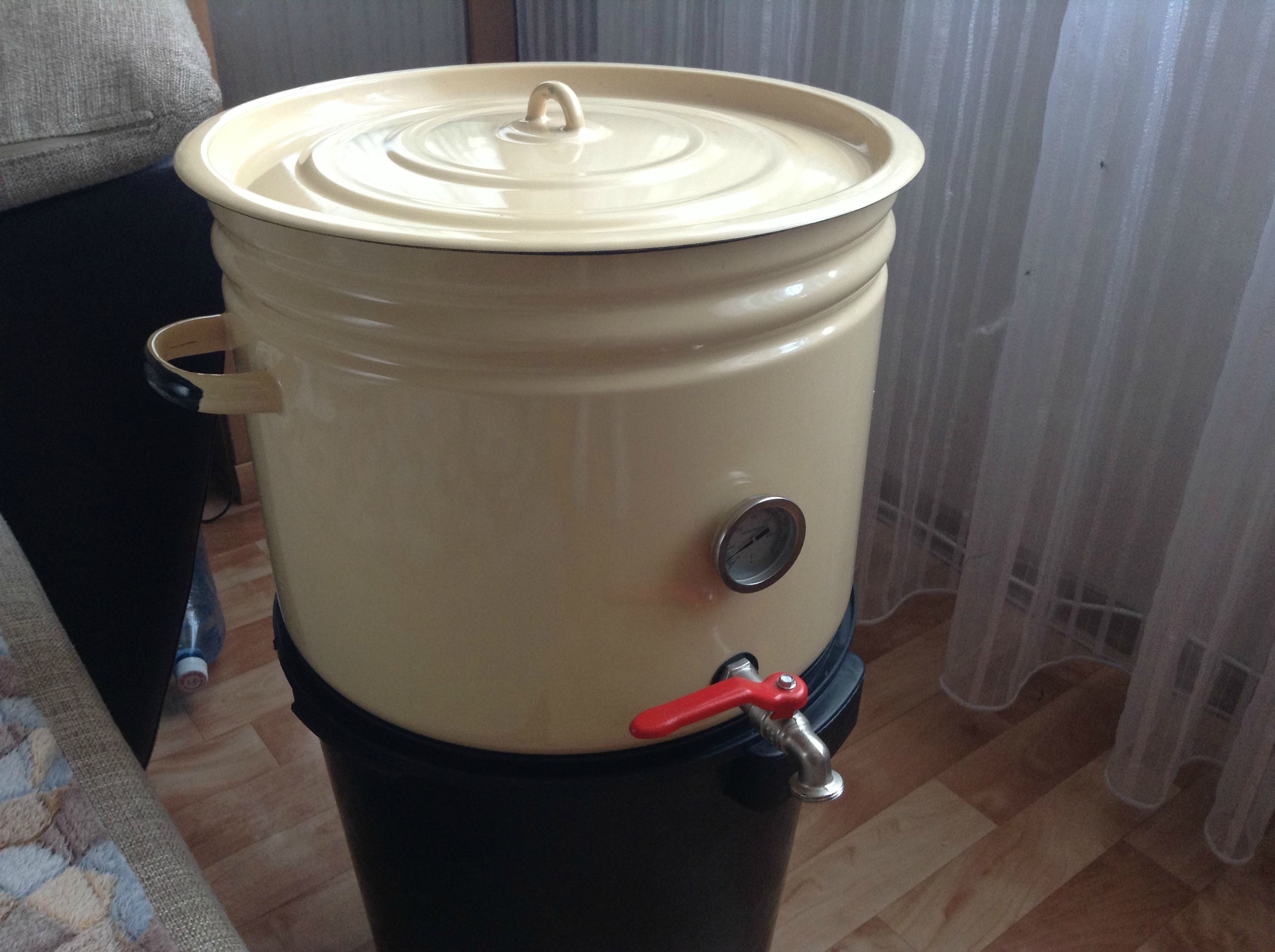
- Next, we make a filter system from a copper tube and fittings. The outer dimensions of this frame should fit into the circumference of the tank bottom with some margin. The tubes are cut to half the diameter with a grinder, the burrs are removed with sandpaper. Using copper elbows of the same diameter, a closed rectangle with a tee on one side is assembled from the cut pipes. It is easiest to connect pipes with elbows and tees on rivets using a riveter. Correctly selected diameters of the tube, elbows and tees provide a fairly tight connection. A curved tube with a union nut of DN 15 mm is connected to the tee, which is put on the tee tube, after which this tube is expanded to hold the nut. The filter system is ready. It connects to an adapter on a tap inside the tank.
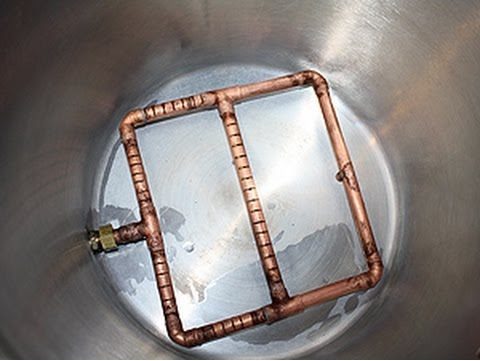
- Cooler or refrigerator, or more simply - an ordinary coil. It is easy to make from the same copper tube or stainless steel metal hose. Just wind a pipe or metal hose in a spiral around some template: a small barrel, a pipe cut or an ordinary bucket. Its dimensions should allow it to be immersed in a wort cooling tank. Both ends of the coil are led out beyond the upper edge of the tank and are equipped with bushings with union nuts. The sleeves are tightly inserted into the tubes or ends of the coil metal hose and crimped to form a tight connection. The chiller is ready. Water supply and discharge are organized by rubber hoses (rubber-fabric hoses) of a suitable size with threads for the captive nuts of the coil.
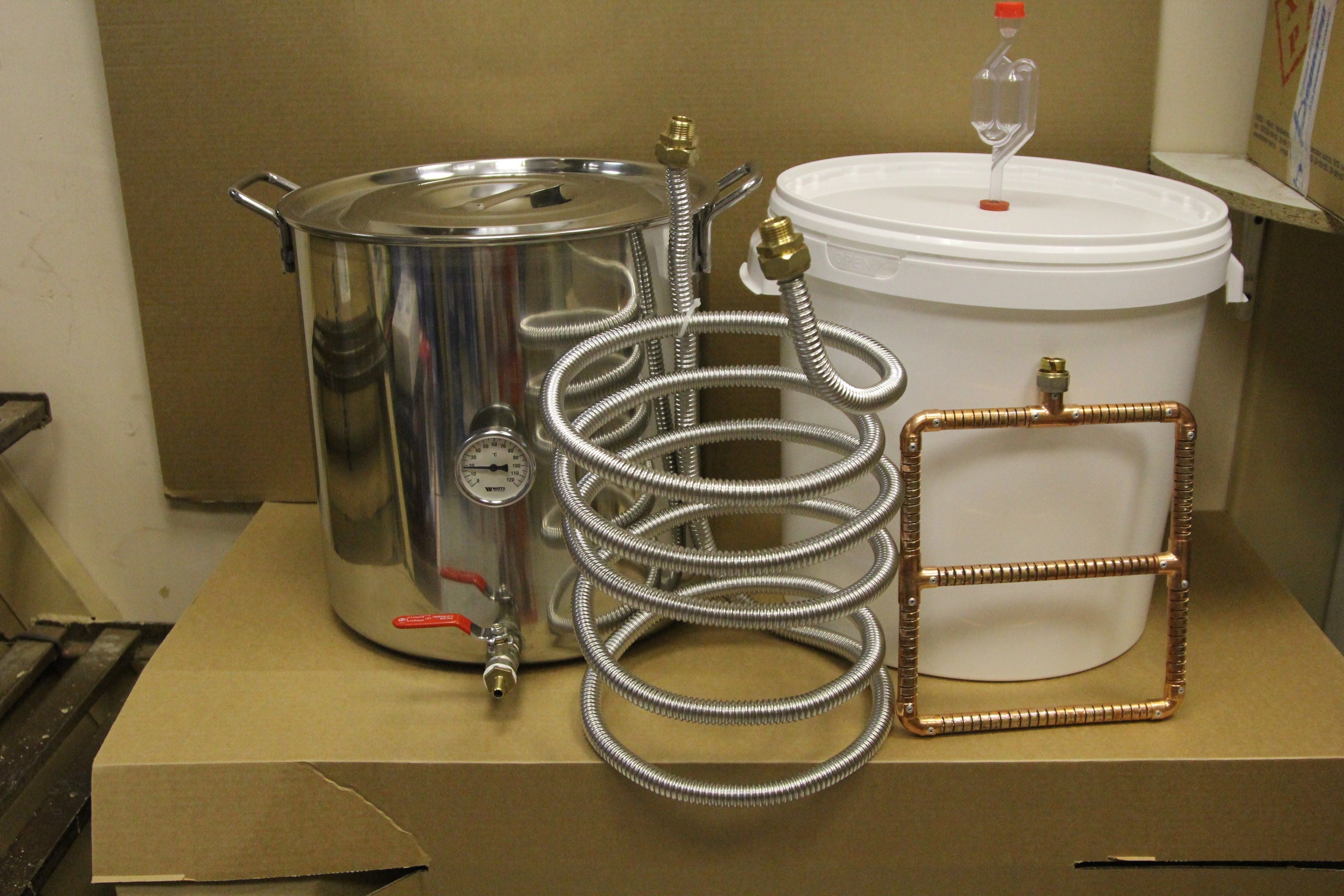
At the end of the work, you will become the happy owner of a quite decent device, the cost of which will hardly exceed 2,000 rubles.
Criteria for choosing a mini brewery
The process of brewing beer has always been considered very difficult and time consuming to carry out at home. Perhaps, true enthusiasts of this business could do it. They had to make their own equipment, look for raw materials, or even grow it on their own (except for yeast). Now a set of everything you need to create your masterpiece can be bought at an affordable price. There are so many home installations on the market that it is difficult for a beginner to understand their advantages and disadvantages. In order not to make mistakes, let us consider the main criteria for choosing the necessary and sufficient set of equipment.
Grain and extract beer
Above is the method for preparing grain beer. Experts call it all-grain. The scheme is as follows:
- first you need to prepare malt: germinate and dry the grains of wheat, rye or barley, crush them (not into flour);
- rub the wort;
- add hops (hop);
- add yeast and control the fermentation for a week, maintaining the temperature at 24 - 25 ° C and observing the bubbles of carbon dioxide in the water seal;
- pour the product into bottles without disturbing the sediment in the fermentation tank;
- add sugar or dextrose, cork the dishes and leave to carbonate for 20 days;
- move the finished drink to the refrigerator and let it ripen for another month.
Now let's look at the process of making an extract beer. It differs from all-grain by the use of ready-made malt extract obtained by dehydrating the finished beer wort. It can be powder or syrup. The beginner receives a semi-finished product, which must be diluted in water according to the instructions, and get to work.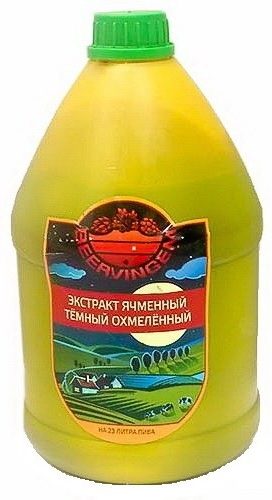 Moreover, the extract may already be hopped. In this case, it remains to dilute it with clean water, add yeast, close tightly, install a water seal and leave the fermentation vessel in a dark room with a temperature of 24 - 25 ° C, periodically looking at the bubbles in the water seal.
Moreover, the extract may already be hopped. In this case, it remains to dilute it with clean water, add yeast, close tightly, install a water seal and leave the fermentation vessel in a dark room with a temperature of 24 - 25 ° C, periodically looking at the bubbles in the water seal.
The extract method of preparing the drink is much simpler and not as laborious as the cereal one. If a beginner wants to experiment with the taste of the future drink, he can choose an un-hopped extract and add hops of his choice and understanding, adhering to a certain recipe or inventing his own recipe.Various types of extract and hops are commercially available, so there is still an element of creativity in the extract method, although not on the same scale as in grain.
Choosing an extract brewery
To understand how to choose the right installation, beginners should find out how much a particular model costs and what is the required minimum of equipment and ingredients, without which it is unthinkable to start the extraction process:
- First of all, a vessel for fermentation is needed - a fermenter, in the lower part of which a drain valve is mounted, and the lid is equipped with an opening for mounting a water seal.
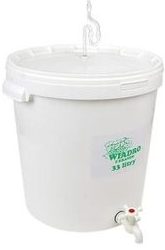
- A water trap is a device through which carbon dioxide leaves the fermenter during fermentation. Mounted with seal.
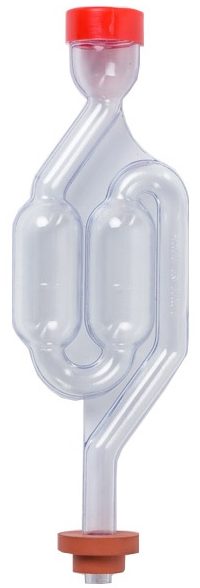
- Thermometer for regulating the fermentation temperature within a given range. The LCD thermometer on adhesive tape has proven itself very well. It is glued to the outside of the fermenter. Very comfortably.

- Hydrometer. The device used to measure the density of the wort. In our case, it determines the strength of the beer.
- Overflow siphon. It is used to drain the finished product without disturbing the sediment.
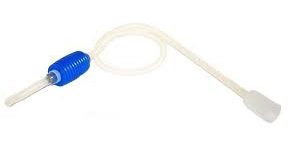
- Disinfection tablets. Treating the dishes to kill bacteria and wild yeast is essential for a quality drink. Chlorine tablets are sold separately and are inexpensive.
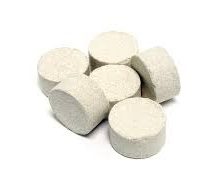
- Cookware for the finished product. Anything that can be tightly sealed will do: plastic soda bottles, glass containers for drag corks, glass bottles without threads.
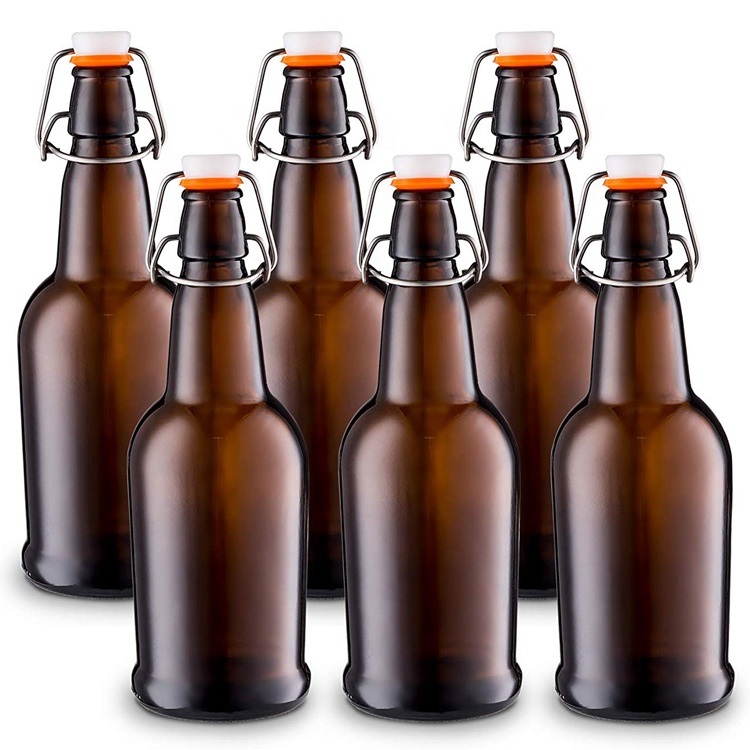 The latter are sealed with crown corks using a special device - a capper, which works on the principle of a machine for seaming glass jars.
The latter are sealed with crown corks using a special device - a capper, which works on the principle of a machine for seaming glass jars.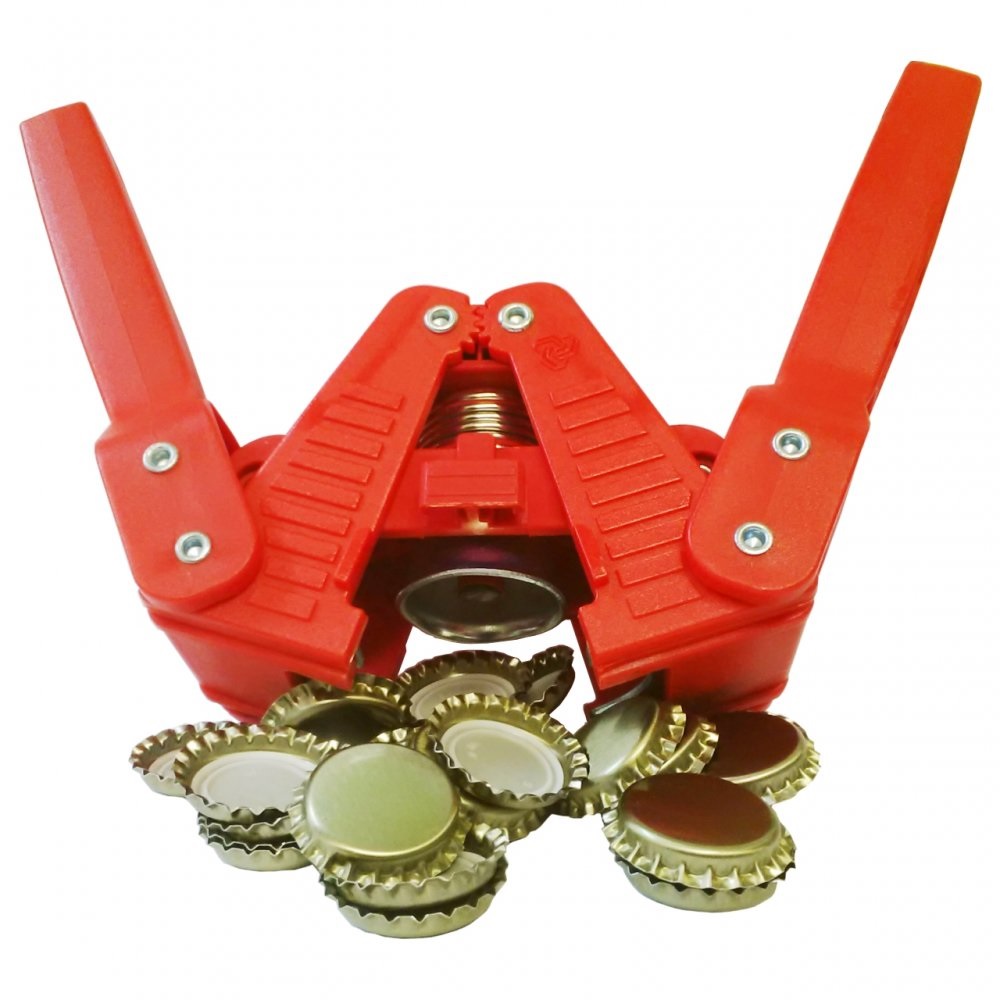
Of the ingredients in the set, there is always a package with dry or liquid malt extract, which may already be hopped or unhopped. In the latter case, you will also need hops. Yeast and dextrose (sugar) are purchased separately to increase the gravity of the wort and carbonate the beer. The set comes with detailed instructions for preparing the extract foam.
Choosing a grain brewery
For the preparation of the all-grain product by the method, the following equipment of the extract kit is added to the listed set of equipment:
- A container for boiling wort and adding hops, which is called a wort kettle. This is usually a stainless steel pot with a lid and a tap.
- In more expensive and advanced kits, a filtration system, a thermometer, preheating, a circulation pump, automatic control and other useful things are provided.
- Malt grinder.
- Wort cooling device. Copper or stainless steel threaded coil for cold water inlet and outlet. It is immersed directly into the brewing tank, one end joins the water, with the second hose the water is discharged into the sewer.
- Wort stirring paddle.
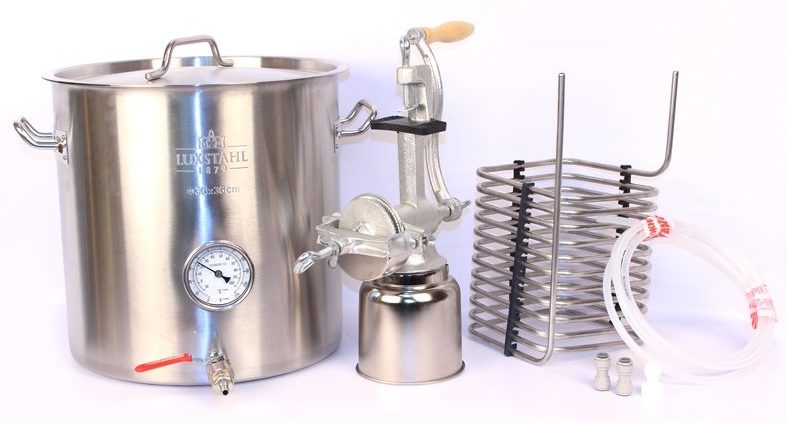
The ingredient list starts with the malt or malt blend. Then hops, brewer's yeast, dextrose and all the same disinfection tablets are added. Experienced craftsmen use additional ingredients to clarify the drink, Irish moss algae, etc. In addition, detailed instructions on how to make grain beer are required. You need to have a malt scale and a very accurate scale to measure the amount of hops you need.
Choosing a product by price
The cost of a product is the main factor influencing the decision to buy or not buy. When choosing a model for an extract method of preparing a drink, you should think about the fact that this is nothing more than a barrel, usually a plastic one, with a tap near the bottom and a hole in the lid. And that's it! As a rule, these are budget devices costing no more than 3000 rubles.
The grain set assumes, at a minimum, a stainless steel container, with the same tap and thermometer in the body. It is desirable that the walls of the container are not too thin. Then the vessel will last longer, and the thermal processes will run more smoothly. Here the price difference will be significant. The simplest apparatus for the all-grain method, taking into account the cost of the tank, will cost the buyer 40,000 rubles.If this is a unit with a double wall (a steam-water jacket), a filter, a submersible chiller, a circulation pump and electronic control, cook at least 100,000 rubles for a 10 liter container and up to 300,000 rubles for a 50 liter tank. So with the most burning desire, you will have to take into account your capabilities. If the kit is being bought for a business, it's worth shelling out. In other cases, it is better to look for something more affordable.
Top Home Brewers
It is more profitable to buy any household goods from the best manufacturers. Models from Germany are famous for their high quality and set and ingredients. Braumeister 20 L, a fully automated complex for preparing a drink in a grain manner, with an electric brew kettle. 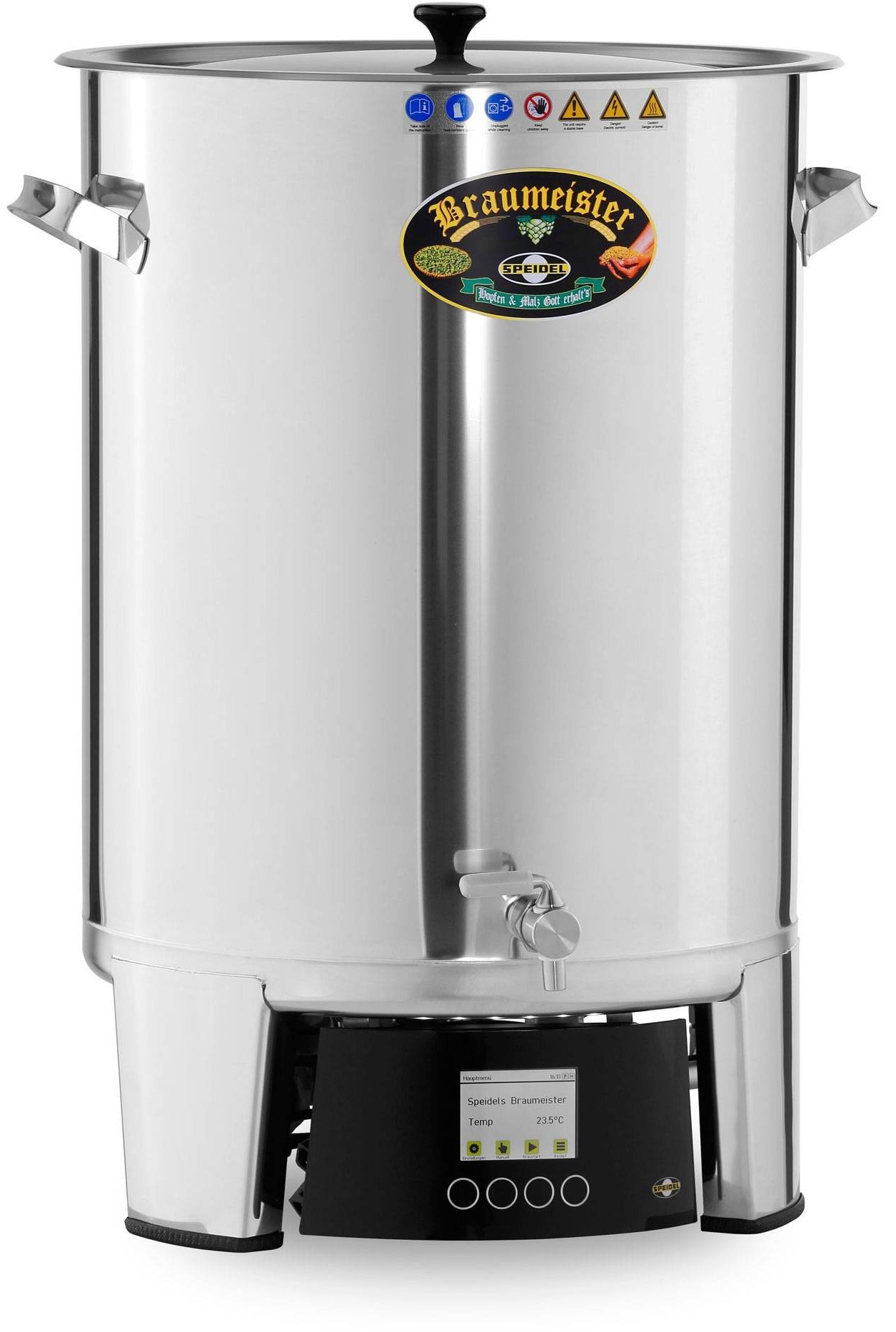 You just need to put the ingredients in it and choose a program. The machine will do the rest.
You just need to put the ingredients in it and choose a program. The machine will do the rest.
The USA in this market is represented by BrewDemon, Mr. Beer, FastFerment, made in the image and likeness of industrial units. The popularity of these models is due to their thoughtful manufacturability. The fermenter body is made in the form of a CCT - a cylindrical-conical tank made of plastic. This shape allows you to make a high-quality product, due to the fact that the yeast, having worked out, sinks into the conical part of the body and does not get into the bottles in any way when bottled.
Russia also keeps up with the world beer powers, presenting its popular models: Beer Zavodik, Beerwivgem, Bavaria and others. Czech InPinto, Hungarian Brewie and Slovenian Brewiks received the best customer reviews. Of the Chinese grain models, the 50 liter Easy Brew with a programmable cycle deserves attention.
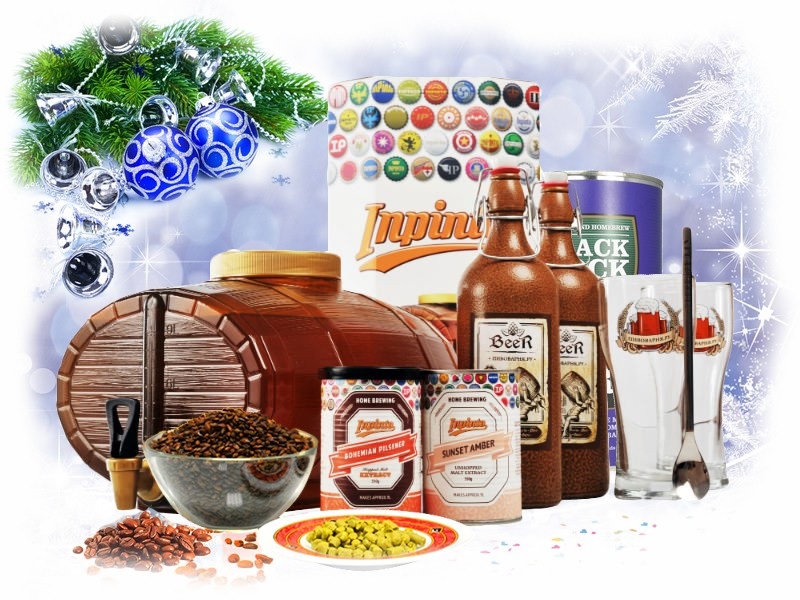
There are a lot of manufacturers of quality installations. Some rely on the simplicity of the device, more suitable for beginners, others focus on an advanced user who is concerned with the high quality of their work, while others promote their goods at the expense of a low price. It is up to the buyer to decide which company the product is better to buy. To make the right choice, it is worth listening to the advice of experienced users of such equipment.
Other features of home breweries
What else should you pay attention to when buying:
- Plant dimensions depend on the size of the fermenter, (extract models) or wort. The minimum volume of fermenters is 8 - 10 liters. Such a device is quite suitable for a kitchen in a standard apartment. Further, the volumes increase with different gradations, up to 50 liters. The volume of more than 50 liters for a home model is perhaps too large. However, this is a master's business. If you have where to place the device and who can use the product in such a volume, then why not
- Structurally, the devices can be collapsible and prefabricated. Since the practice of "potions" is unlikely to be daily, the collapsible option seems preferable. However, not everything is so simple. The device must first of all be sealed. If the tank is collapsible, this condition will necessarily be violated over time due to a worn seal or destruction of the body at the joint.
- Design. If the buyer is only interested in the process, this criterion can be ignored. A model like Beer Zavodik Standart, or Brewery.Ru, which is nothing more than a plastic bucket with a tap and a lid, is quite suitable. If one of your friends is fond of this business, you can give him a design option for his anniversary. It can be a stylized wooden barrel, a plastic Russian model Beervingem premium, or a similar barrel by the Czech manufacturer Inpinto (Premium, Bar, Standart).
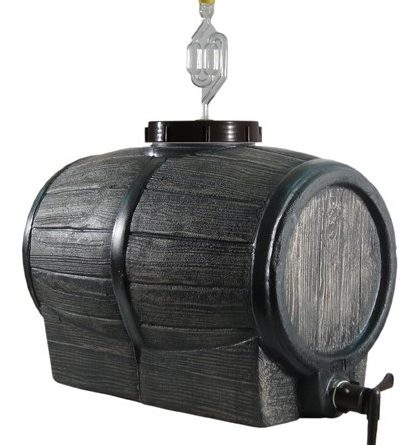 The devices of the American manufacturer FastFerment with a plastic case, in the form of a ckt (cylindrical-conical tank), look very interesting and very technological.
The devices of the American manufacturer FastFerment with a plastic case, in the form of a ckt (cylindrical-conical tank), look very interesting and very technological. This option looks fantastic. The lucky one who received such a gift will be able to feel like a medieval alchemist.
This option looks fantastic. The lucky one who received such a gift will be able to feel like a medieval alchemist. - Equipment. In addition to the fermenter of the water seal and the extract for the first experience of making a drink, the delivery set may include: a paddle for mixing the composition. hoses for draining the finished potion, disinfectants for washing and drying bottles and the bottles themselves for the finished product. Most often, the kit includes plastic bottles.The InPinto 2010 model includes ceramic bottles with drag stoppers. A great gift.
- Maximum and minimum brewing time. The extract method is less labor-intensive and lasts from 4 to 28 days, depending on the volume of the fermenter, the quality of the ingredients and the type of carbonation (natural or forced). This is without taking into account the final ripening time. The grain method is longer. It will take time to cook the malt and boil the wort.
Rating of quality samples from home breweries
We present an overview of quality models in 2020, based on customer reviews and expert estimates.
Brewery.Ru light
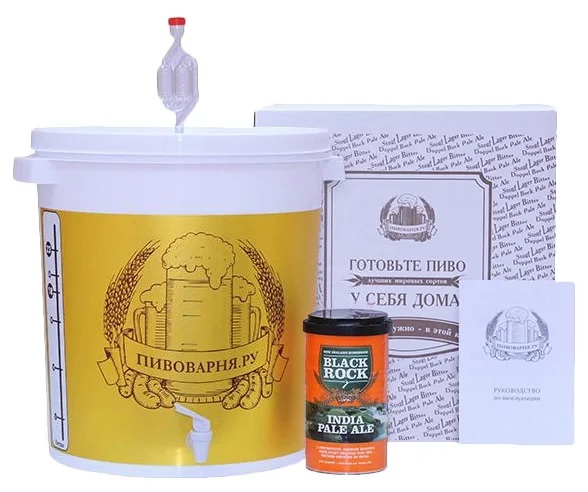
The tenth place in the rating is occupied by Brewery.Ru light. The name itself suggests that this device is manufactured in Russia. The delivery set includes a plastic fermenter for 30 liters, complete with a thermometer and a water seal. In addition, the model is equipped with a kilogram pack of Inpinto Pilsner liquid extract and 1 kg of dextrose. A beginner can only buy and start. Detailed instructions are provided on the surface of the fermenter. Average price of a set: 2500 rubles.
Advantages:
- affordable price;
- short preparation time of the drink;
- natural carbonation.
Disadvantages:
- lack of paddles for mixing;
- lack of disinfectants.
Beer Zavodik standart
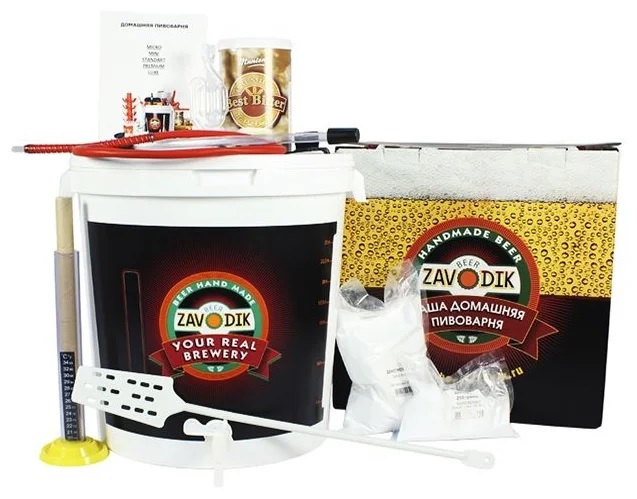
The ninth line of the rating was taken by a 30-liter apparatus with the necessary set of ingredients from the Russian company Beer Zavodik standart. A very simple budget model with natural carbonation. Supplied complete with liquid extract, dextrose and disinfectants. The plastic fermenter is complemented with a thermometer, hydrometer with cylinder, water seal, filter tube and overflow siphon with holder. Dimensions are small 41 * 41 * 41 cm, weight - less than 5 kg. Average price: 3190 rubles.
Advantages:
- the model is easy to operate;
- good equipment;
- Excellent value for money and quality.
Disadvantages:
- not identified.
FestFerment Delux Kit
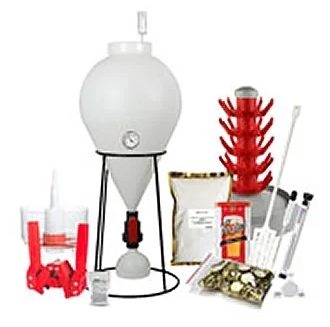
In eighth place in the ranking is the representative of the United States FestFerment Delux Kit. The model is distinguished by well-thought-out manufacturability. Plastic fermenter with a volume of 30 liters is made in the form of a cylindrical-conical tank (CCT). This shape is given to industrial devices in order to trap waste yeast and other by-products of fermentation in the lower part of the fermenter cone, preventing sediment from entering the finished product when pouring into bottles. The set includes a special container for collecting sediment and yeast. It is connected to the drain valve. All unnecessary sediment can be drained. This design allows you to do primary and secondary fermentation (carbonization) in one vessel and get a high quality drink. Delivery includes liquid extract and dextrose, disinfectant, bottle dryer washer, 100 pieces of crown caps and a seaming machine. Average price: 8400 rubles. According to buyers, the model has the best value for money.
Advantages:
- thoughtful technology;
- fermenter design;
- removable tank for sediment removal;
- crown caps and capper included.
Disadvantages:
- the height of the apparatus with the stand is almost 90 cm, which is not very convenient when pouring the wort into the fermenter.
BrewDemon basic Plus
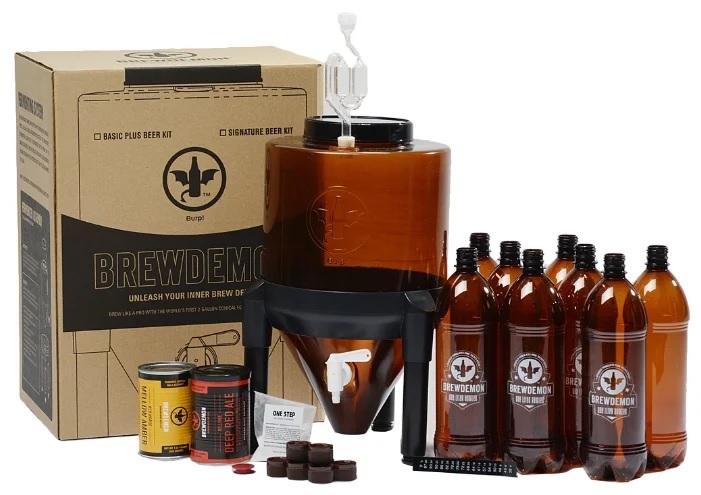
The seventh line on our list is occupied by another representative of North America, the BrewDemon basic Plus extract complex. Like the previous model, it has a plastic fermenter cct with a volume of 11 liters. Equipped with a water seal, a self-adhesive thermometer, 1 liter plastic bottles (8 pcs.) For the finished product, with the same number of branded labels, Hillfire Deep Ale Plus liquid extract. Average price: 6800 rubles.
Advantages:
- affordable price;
- CCT corps;
- interesting design, suitable as a gift option.
Disadvantages:
- the fragile case may be damaged if dropped;
- poor equipment, lack of disinfectants and dextrose for the first brew.
InPinto Premium
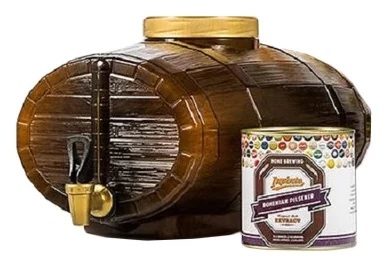
The sixth in our list is the model from the Czech Republic InPinto Premium.This is a nine-liter plastic vessel for the extraction industry, made in the form of an oak barrel. Buyers claim that the drink brewed in this device is not inferior to the famous Czech beer in taste, color or foam. The delivery set includes: a can of liquid extract, yeast, an LCD thermometer disinfectant, a water seal, a stirring paddle, PET bottles. The average price of a set is 5600 rubles.
Advantages:
- great design;
- good equipment;
- excellent taste of the drink.
Disadvantages:
- small volume of the fermenter.
Mr. Beer Premium Kit

In fifth place in our rating, the American apparatus - Mr. Beer Premium Kit. This is a small kitchen model made of hard plastic, stylized as a wooden barrel. Equipped with a tap and a cover. The bottom is made with a sump for waste yeast and sludge, therefore, their ingress into the finished product is excluded. The kit includes beer mix and yeast bag for making light light beer, disinfectant, detailed process description, instructions on DVD, LCD thermometer, metal stirring paddle and plastic bottles (8 pcs.). Average cost of a set: 6500 rubles.
Advantages:
- affordable price;
- stylish design;
- good equipment.
Disadvantages:
- instead of a water seal, there is a gas relief valve at the top of the fermenter.
Beervingem Premium
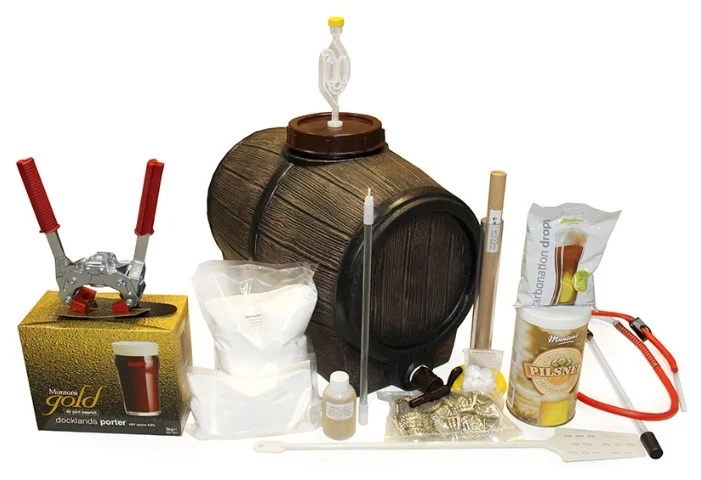
The fourth in the ranking is Beervingem Premium. Russian-made set with a plastic fermenter barrel, stylized as oak. It has a very good package, including a water seal, a thermometer, two types of liquid extract, and a disinfectant. In addition, the supplier has included an additional 80 pieces. crown caps, lollipops and dextrose for carbonation and giving the drink a unique taste, overflow siphon. Average price: 15,500 rubles.
Advantages:
- stylish design;
- two types of extract;
- dextrose + carbonation lollipops;
- excellent equipment.
Disadvantages:
- the price is too big.
SS Brewtech backet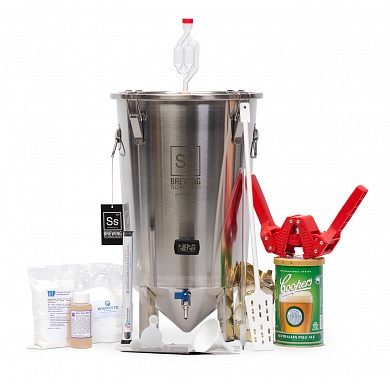
In third place is the product from the leader in the production of minifermenters, the well-known American manufacturer SS Brewtech backet. Such a complex is suitable for both a beginner and an experienced master. The average price is 21,900 rubles. At first glance, this is a lot. But for this money, the buyer will receive a fermenter with a conical bottom for collecting sediments and waste yeast. The container body, made of stainless steel, will serve the owner for many years. The fermenter comes with:
- extract;
- one kilogram of dextrose;
- a spoon for stirring the wort;
- dextrose dispenser spoon;
- thermometer and water seal;
- bottle sealer;
- dish disinfectant;
- silicone hose for product discharge.
Advantages:
- fermenter made of stainless steel;
- conical bottom for collecting sediment and patented rotary valve for draining;
- good equipment.
Disadvantages:
- high price.
Good heat Prague
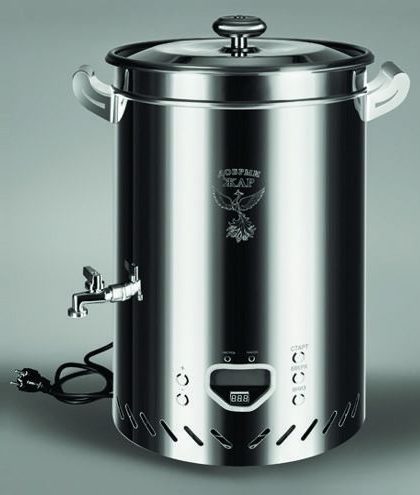
The buyers gave the second place to the Russian apparatus Dobry Zhar Praha. An automatic model for experienced craftsmen who prefer the grain method of making a frothy drink. A stainless steel tank with a volume of 35 liters, eliminates the possibility of product sticking, easy to clean, chemically neutral. The presence of 10 standard and 40 user programs allows you to produce a product with a guarantee of quality with significant savings in the time of the master. The package includes:
- wort tank with lid, display, heating element;
- malt silo with a sieve;
- water-cooled chiller;
- bazooka filter;
- overflow pipe for draining the wort;
Even a person who is not familiar with advanced technologies can deal with the control unit and programs. The correct brewing and wort heating control is controlled by a thermometer built into the control unit. The model is equipped with a controlled pump for mashing malt and stirring the wort, a stainless steel mash tank. The average price of this splendor is 51,000 rubles.
Advantages:
- high-quality assembly and materials;
- excellent equipment;
- wide functionality;
- full automation;
- the complex is suitable for use by beginners and professionals.
Disadvantages:
- high price.
Bavaria 30 l with Wi-Fi unit
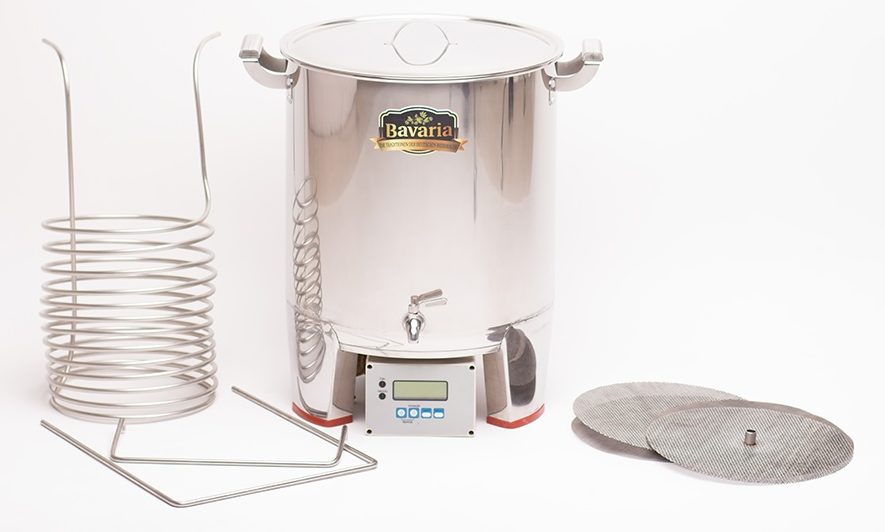
The best customer reviews and the first place in the rating was earned by the Russian machine for brewing grain beer Bavaria 30 liters, with the function of controlling and monitoring the preparation of a drink from a remote access. The cooking process with this device is simplified as much as possible. Mashing and subsequent boiling take place in one stainless steel tank. Automation allows you to control all stages from the temperature pause to the introduction of hops. You can control the action from your personal account or using the mobile application. The average cost of the device is 51,900 rubles.
Advantages:
- great design;
- excellent technical characteristics;
- high quality materials and assembly;
- the ability to control from remote access.
Disadvantages:
- high price.
Summary of brewery ratings
| Brewery name | Specifications | average price |
|---|---|---|
| Bavaria 30 l. with Wi-Fi block Russia | Wort output - 10 l Power - 2500 W Boiler volume - 30 l Weight - 13.3 kg Dimensions - 350 x 470 mm Output per wort cycle, l - 10 liters Maximum mash tank filling weight - 3.5 kg Power consumption - 0.8 - 1.5 kW Risks on the central pin correspond to approximately - 8, 13, 17 L. High-performance pump: up to 600 liters / hour; | RUB 51,900 |
| Kind warmth Prague Russia | Made of food grade stainless steel AISI 304; programmable control unit with 40 user and 10 standard work programs; thermometer integrated into the control unit; submersible efficient chiller; Heating element for 2.5 kV; controlled pump Wester; mash tank for 6 kg of malt with a mesh raised bottom; | RUB 51,000 |
| SS Brewtech backet USA | Material - stainless steel; beer mix included; dry extract type; natural carbonation; water seal and thermometer included; dimensions 52.07x31.75x31.75 cm; weight 5.44 kg; The set also includes: 1 kg of dextrose, a dispenser, a detergent and disinfectant, a funnel, a silicone tube, a dosing spoon for sugar, a seaming machine; stirring spoon; crown caps included. | RUB 21,900 |
| Beervingem Premium Russia | Keg volume 30 l; material plastic; there is a beer mix; natural carbonation; the type of extract is liquid; there is a water seal; there is a seaming machine; there is a stirring spoon; there is a measuring capacity; the set also includes: extracts Muntons Premium 1.5 kg and Muntons Gold 3 kg; 80 crown caps; disinfectants Star San HB - 100 ml, DEO-Chlorine, Muntons lollipops - 160 g; dextrose packs 1 kg and 250 g; overflow siphon | RUB 15500 |
| Mr. Beer Premium Kit USA | keg volume 8.5 l; material plastic; minimum brewing time for beer 7 - 28 days; there is a beer mix; natural carbonation; the type of extract is liquid; there is a thermometer; there is a stirring spoon; bottles included; the material of the bottles is plastic; there is no wort in the kit. Additional Information: the set also includes: DVD with instructions, 8 plastic bottles of 1 liter. | 6500 RUB |
| InPinto Premium Czech Republic | Keg volume 9 l; material plastic; the minimum brewing time for beer is 4 - 21 days; there is a beer mix; natural carbonation; the type of extract is liquid; there is a thermometer; there is a stirring spoon; bottles included; the material of the bottles is plastic; there is no wort in the kit. | 5600 RUB |
| BrewDemon basic Plus USA | Keg volume 11 l; material plastic; the minimum time for making beer is 7 - 14 days; there is a beer mix; natural carbonation; the type of extract is liquid; there is a water seal; there is a thermometer; bottles included; the material of the bottles is plastic; the wort is not included; dimensions (HxWxD) 40x22x22 cm. Additional Information. The set also includes: 8 1 liter bottles, 8 branded stickers, Hellfire Deep Red Ale Plus extract. | RUB 6800 |
| FestFerment Delux Kit USA | Keg volume 30 l; material plastic; natural carbonation; the type of extract is liquid; there is a water seal; there is a thermometer; there is a stirring spoon; there is a measuring capacity; Crown plugs included; the wort is not included; dimensions (HxWxD) 90x37.5x37.5 cm; weight 4.8 kg; Additional Information the ability to carry out primary and secondary fermentation in one container; unscrewing container for collecting sediment; the set also includes: a device for washing and rinsing bottles - model VINATOR, a rack for drying bottles (45 pieces), a device for manual bottle capping with crown caps and 100 caps, hydrometer, Chemipro OXI disinfectant; Roquette dextrose, Coopers extract. | RUB 8400 |
| Beer Zavodik standart Russia | Keg volume 33 l material plastic minimum brewing time from 21 days beer mix included natural carbonation extract type liquid there is a water seal there is a thermometer there is a stirring spoon wort is not included dimensions (HxWxD) 41x41x41 cm; Weight 4.7 kg Additional Information: filter tube, hydrometer with cylinder, overflow siphon with holder; disinfectants Deo-chlorine, dextrose (1 kg + 250 gr.) | RUB 3190 |
| Brewery. Ru light Russia | Keg volume 30 l; material plastic; the minimum beer preparation time is 6 - 16 days; there is a beer mix; natural carbonation; the type of extract is liquid; there is a seal; there is a thermometer; the wort is not included; dimensions (HxWxD) 36x38x38 cm; weight 3 kg; Additional Information: Inpinto Pilsner extract 1 kg - 2 pcs., dextrose 1 kg. | 2500 RUB |
The assortment of beers of different colors, flavors and strengths is so wide that the very idea of brewing at home at first seems ridiculous. However, the number of fans of this fascinating activity is growing every year. This is creativity in its purest form, as a result of which you can get a unique drink available only to you and your inner circle. In addition, unlike a store product, which is prepared from no one knows what, it is not clear by whom and in what sanitary conditions, you are preparing a product that you know everything about, and you can drink it without fear.
This is a good business idea or a variant of expanding an existing business, because humanity has been drinking beer for several millennia and is not going to give up this pleasure. 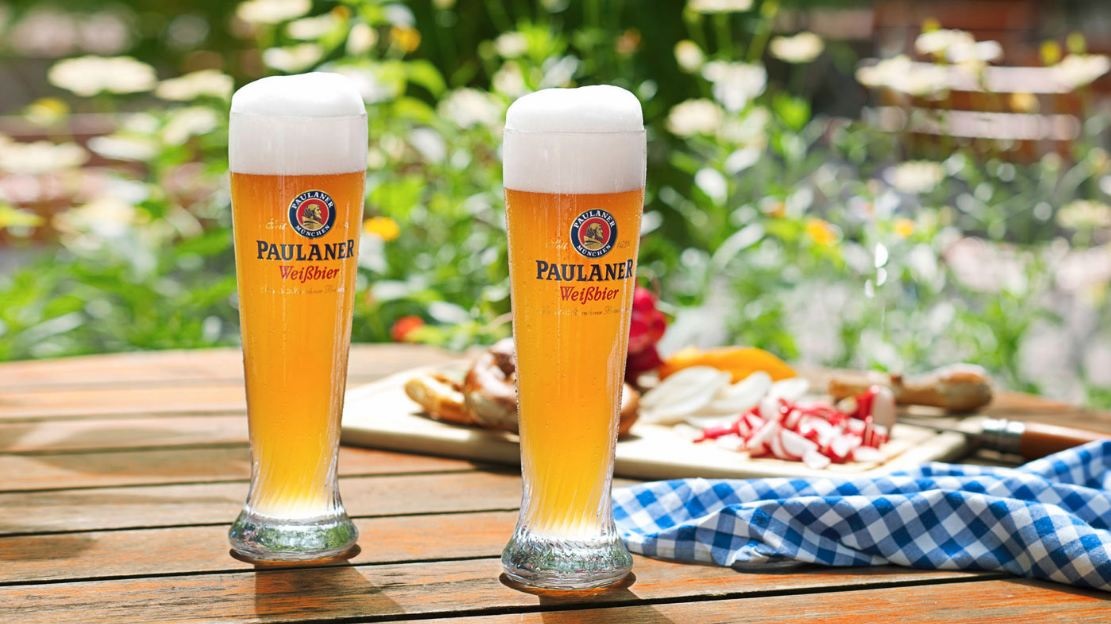 What if this is your business and your future? To find out, you should make a decision, buy a homebrewery and brew your favorite drink. Our site will help you not to make mistakes when choosing a suitable model.
What if this is your business and your future? To find out, you should make a decision, buy a homebrewery and brew your favorite drink. Our site will help you not to make mistakes when choosing a suitable model.












